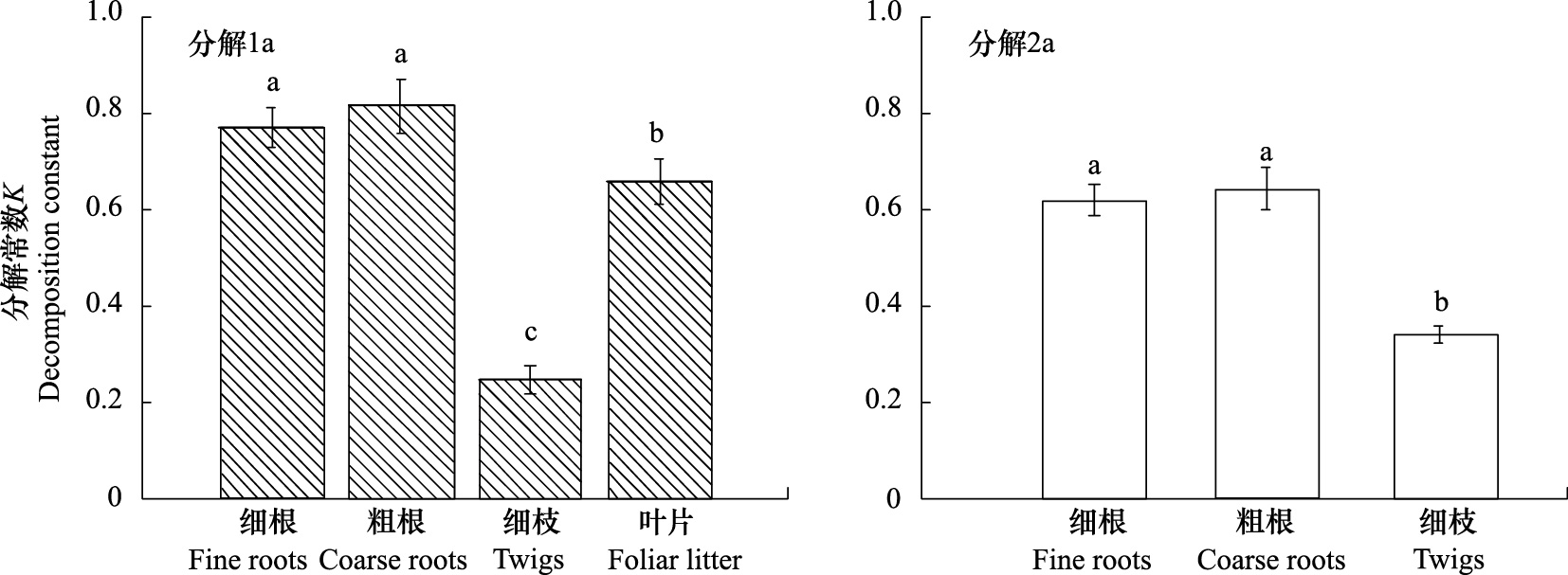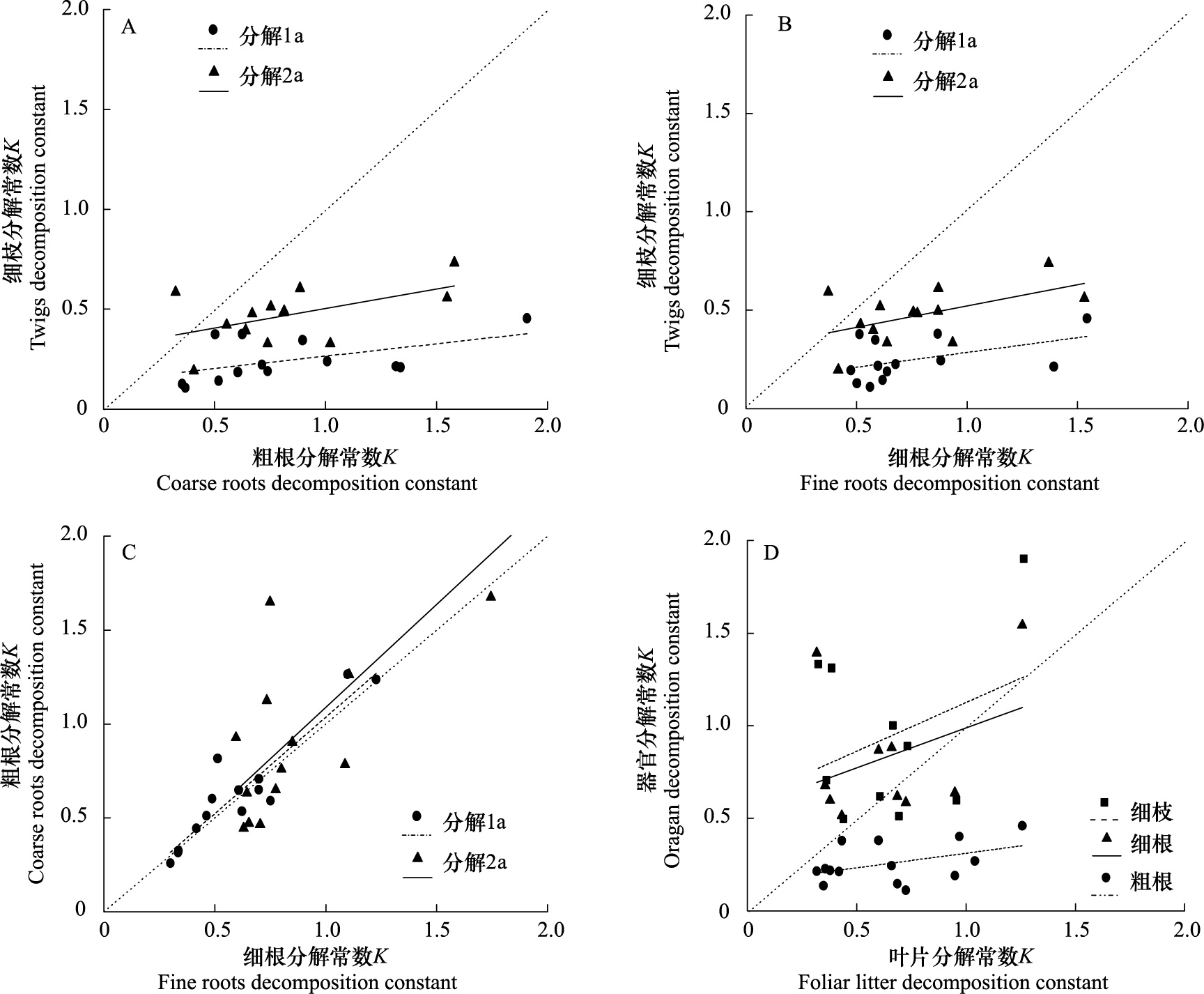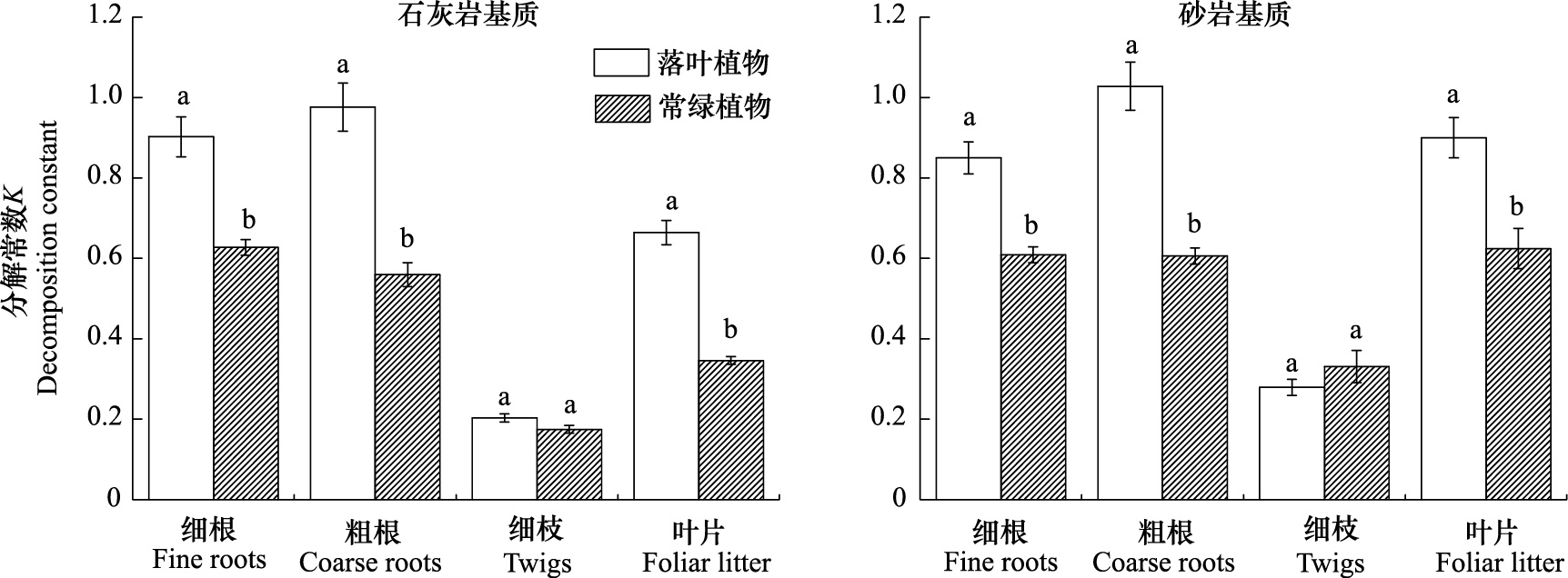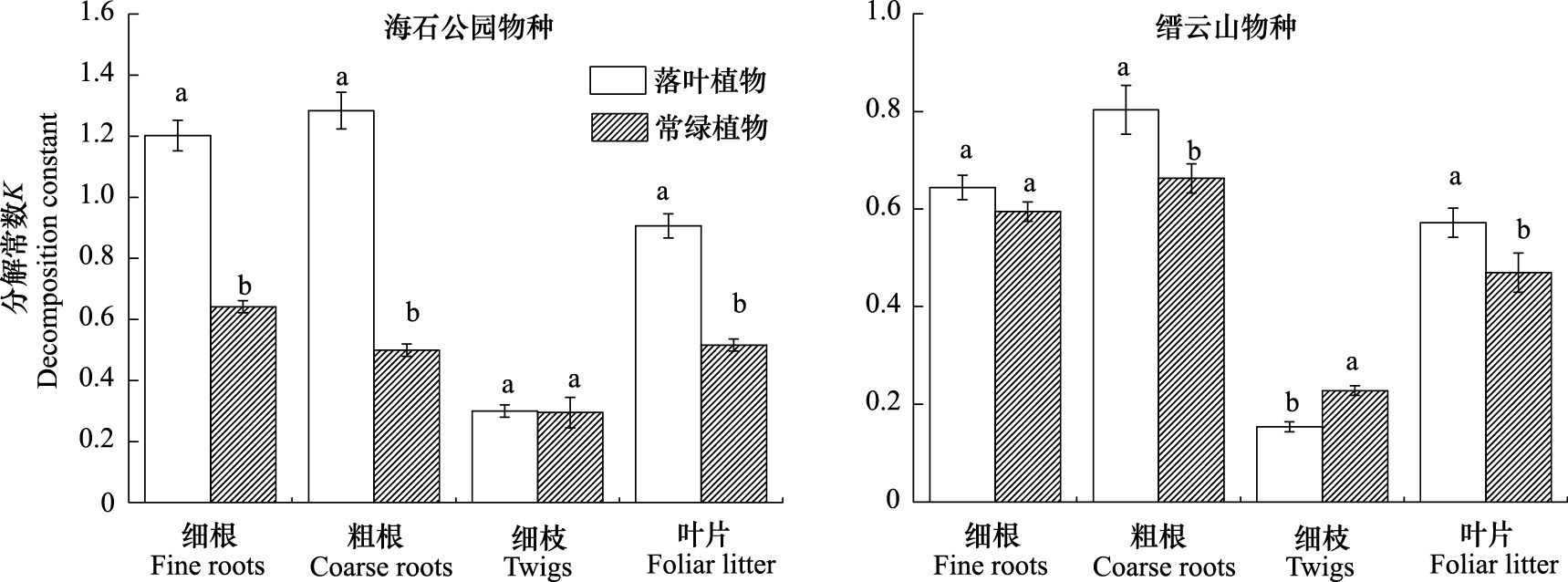文章信息
- 刘文丹, 陶建平, 张腾达, 钱凤, 柴捷, 刘宏伟
- LIU Wendan, TAO Jianping, ZHANG Tengda, QIAN Feng, CHAI Jie, LIU Hongwei
- 中亚热带木本植物各器官凋落物分解特性
- Decomposition of above and belowground organ litters of mid-subtropical woody plants
- 生态学报, 2014, 34(17): 4850-4858
- Acta Ecologica Sinica, 2014, 34(17): 4850-4858
- http://dx.doi.org/10.5846/stxb201307211925
-
文章历史
- 收稿日期:2013-7-21
- 网络出版日期:2014-3-13
凋落物及其分解对森林更新、土壤微生物多样性及生态系统物质循环具有重要意义[1, 2]。影响凋落物分解的主要因素有凋落物底物质量、气候、土壤基质和微生物群落[3, 4, 5],其中凋落物底物质量与植物功能性状相关。木质素、干物质含量、N含量、P含量及酚类等功能性状都属于凋落物底物质量[6]。同时植物对资源的利用方式(即生态对策)决定植物的功能性状[7, 8],如干旱地区的植物普遍叶片较厚[9],从而可把植物凋落物分解与其生态对策联系起来[10]。在长期的物质循环过程中,植物通过协调地上、地下各器官形成一致的生态对策以适应生长地区的气候与土壤条件[11]。Kerkhoff等[12]发现同种植物的叶片、枝条及根的N含量、P含量具有相关性,Freschet等[8]进一步研究得出植物各器官的功能性状具有一致性。目前关于植物各器官凋落物间分解相关性的研究较少,且结果存在差异。Hobbie等[13]对11种温带植物凋落物的研究表明在相同气候条件下叶片与细根间的分解没有联系,而Wang等[14]的结论与之相反。因而,进一步探讨:(1)器官功能性状上的一致性对于分解有什么影响?(2)是否同一物种中不同器官间的分解特性存在联系,并具有一定规律?对于人们理解特殊生态系统的物质循环过程及物种生态适应对策有重要意义。由此,本研究分别比较中亚热带地区两种生态系统中不同物种与不同生活型植物间各器官凋落物分解特性及其相关性,探讨生态对策与凋落物分解能力的关系,有利于更好地理解物种适应、养分物质循环及土壤-植物生长-凋落物分解三者的关系,同时也可为森林可持续管理中物种的选择提供参考意见。
1 材料和方法 1.1 研究区域概况研究区域选取亚热带季风湿润性气候区内砂岩基质的缙云山自然保护区及喀斯特地貌的海石公园。缙云山自然保护区(106°20′E,29°48′N)土壤以酸性黄壤为主,植被主要为亚热带常绿阔叶林,物种多样性丰富[15],常见树种有薯豆(Elacocarpus japonicus)、四川山矾(Symplocos setchuensis)、大果杜英(Elaeocarpus fleuryi)等。海石公园(106°18′E,29°39′N)为典型的喀斯特地貌(Karst),以石灰岩山地为主,土壤为石灰岩发育的山地黄壤和山地黄棕壤,土质低劣,岩石裸露,养分贫瘠,不易于保水保肥[16]。适应这种特殊环境的植物具有石生性、耐旱、喜钙(镁)等生态特性,植被覆盖率低[17],构树(Broussonetia papyrifera)、女贞(Ligustrum lucidum)、盐肤木(Rhus chinensis)等是这种生境中的代表植物。
1.2 试验设计2010年10月开始收集新鲜的凋落物(衰老但还未开始分解的凋落物),包括粗根(0.2 cm<直径<0.5 cm)及细根(直径≤0.2 cm)、细枝(直径约为0.5 cm)[18]和叶片。海石公园选择6种植物,缙云山选择8种植物,共14种植物采集粗根与细根;海石公园7种植物,缙云山8种植物,共15种植物收集叶片凋落物;海石公园9种植物和缙云山12种植物,共21种植物采集细枝,具体的植物种名见表 1。每种器官类型在同一植物采集样品的株数不少于3株。凋落叶和枝的选择标准和采集方法依据Cornelissen[19],由于根埋藏于地下,不利于观察分解状况且难以收集枯死的根,同时随着年龄的增长根部逐渐被腐殖类真菌寄居,导致树根在衰老之前已开始分解,造成取材时难以统一材料的分解程度。因此,采集新鲜的根(根据颜色、气味及形状等分辨)作为研究对象[20, 21]。所有样品经过自然风干称重,装入12 cm×8 cm、孔隙大小为0.1 cm×0.1 cm的尼龙网布分解袋中,每袋样品大约为0.5 g。
| 编号 Number | 物种 Species | 生活型 Life form | 根Roots | 细枝 Twigs | 叶片 Foliar litter | 材料采集地 Collection site | |
| 细根 Fine roots | 粗根 Coarse roots | ||||||
| “●”表示具有材料,“○”为无材料 | |||||||
| 1 | 构树Broussonetia papyrifera | 落叶乔木Deciduous trees | ● | ● | ● | ● | 海石 |
| 2 | 盐肤木Rhus chinensis | 落叶乔木Deciduous trees | ● | ● | ● | ● | 海石 |
| 3 | 勾儿茶Berchemia sinica | 落叶灌木Deciduous shrubs | ● | ● | ● | ● | 海石 |
| 4 | 火棘Pyracantha fortuneana | 常绿灌木Evergreen shrubs | ● | ● | ● | ● | 海石 |
| 5 | 柏木Cupressus funebris | 常绿乔木Evergreen trees | ● | ● | ○ | ○ | 海石 |
| 6 | 女贞Ligustrum lucidum | 常绿乔木Evergreen trees | ● | ● | ● | ● | 海石 |
| 7 | 清香木Pistacia weinmannifolia | 常绿乔木Evergreen trees | ○ | ○ | ● | ○ | 海石 |
| 8 | 金山荚蒾Viburnum Chinshanense | 常绿灌木Evergreen shrubs | ○ | ○ | ● | ● | 海石 |
| 9 | 铁仔Myrsine africana. | 常绿灌木Evergreen shrubs | ○ | ○ | ● | ○ | 海石 |
| 10 | 马桑Coriaria nepalensis | 落叶灌木Deciduous shrubs | ○ | ○ | ● | ● | 海石 |
| 11 | 柃木Eurya japonica | 常绿灌木Evergreen shrubs | ● | ● | ● | ○ | 缙云山 |
| 12 | 白栎Quercus fabri | 落叶乔木Deciduous trees | ● | ● | ● | ○ | 缙云山 |
| 13 | 檵木Loropetalum chinense | 常绿灌木Evergreen shrubs | ● | ● | ● | ● | 缙云山 |
| 14 | 四川山矾Symplocos setchuensis | 常绿乔木Evergreen trees | ● | ● | ● | ● | 缙云山 |
| 15 | 薯豆Elacocarpus japonicus | 常绿乔木Evergreen trees | ● | ● | ● | ● | 缙云山 |
| 16 | 杜鹃Rhododendron simsii | 落叶灌木Deciduous shrubs | ● | ● | ● | ○ | 缙云山 |
| 17 | 毛叶木姜子Litsea mollis | 落叶乔木Deciduous trees | ● | ● | ● | ● | 缙云山 |
| 18 | 展毛野牡丹Melastoma normale | 常绿灌木Evergreen shrubs | ○ | ○ | ● | ● | 缙云山 |
| 19 | 大果杜英Elaeocarpus fleuryi | 常绿乔木Evergreen trees | ● | ● | ● | ● | 缙云山 |
| 20 | 马尾松Pinus massoniana | 常绿乔木Evergreen trees | ○ | ○ | ● | ● | 缙云山 |
| 21 | 山胡椒Lindera glauca | 落叶灌木Deciduous shrubs | ○ | ○ | ● | ○ | 缙云山 |
| 22 | 黄牛奶树Symplocos setchuensis | 常绿乔木Evergreen trees | ○ | ○ | ● | ○ | 缙云山 |
2010年于西南大学生态园布置分解床,设置10个2 m×1 m(深度为0.6 m)的单元格,相邻的两个单元格采用木板隔开,且两个单元格间缓冲带的距离大于0.4 m。挖去每个单元格中原有土壤基质,交叉地填入采样地区(海石公园和缙云山)的两种土壤基质。待分解床土壤环境条件稳定后,于2011年1月放入分解袋开始进行分解实验(分解袋平铺、不重叠放置)。枝条和叶片的分解袋放置于分解床土表,根分解袋用15 cm厚的土壤覆盖。分解袋布置完毕后,在分解床上的不同单元格中分别覆盖厚度约10 cm,收集于缙云山和海石公园植物群落内的混合凋落物(同制作分解床的土壤基质相对应),最后盖上铁丝网以阻止鸟类、老鼠等动物的干扰破坏。
每个植物物种的凋落物(粗根、细根、细枝与叶片)分别放入两种基质中进行分解。同一物种的同种类型凋落物每次收获制作10个分解袋,在每种土壤基质中重复数为5。另取凋落物样品烘干至恒重测量含水量,计算分解样品的烘干重。
1.3 分解凋落物样品的收获和处理2012年1月及2013年1月分别回收凋落物样品,包括分解1a后的粗根、细根、细枝、叶片及分解2a后的粗根、细根、细枝。材料取回后清理,除去泥土和混入的杂草根系,于60 ℃烘箱中烘干48 h,称重并记录。
1.4 数据处理运用Olson负指数衰减公式:Xt= Xoe-Kt计算分解常数K的值[22],式中Xt 为调落物残留干重,Xo 为调落物初始干重,t为分解时间(a)。
运用SPSS 20.0软件进行方差分析,用Oringin 8.6绘图。分解常数进行Log转换具齐性后进行数据分析。采用单变量多因素方差分析进行凋落物分解常数三因素方差分析,并运用Dunnett分别进行分解1a及分解2a器官凋落物间分解常数的两两比较。各器官凋落物间分解常数的关系采取Pearson相关性分析,并用SMA(Standardized major axes regressions)进行线性回归[23]。运用独立样本T检验(Independent-samples T test)分别分析不同生活型植物同种凋落物类型在不同采集来源、不同土壤基质分解差异性,统计显著水平均为P=0.05。
2 结果与分析 2.1 各器官凋落物分解比较凋落物的分解分别在器官类型、植物种类及土壤基质间差异极显著(P<0.01,表 2),其中器官类型和植物种类的偏差平方和分别为26.820与12.026。比较根、枝、叶分解1a后的分解常数,显示差异显著(P<0.05),根分解快于叶片,枝条最慢,而细根、粗根分解差异性不显著(图 1)。根、叶、枝相互间分解呈现正相关关系,且细根与粗根、细根与细枝分解呈现出显著正相关(P<0.05,表 3)。
| 分解时间/a Incubation period | 变异来源 Source | SS | df | MS | F |
| **为差异性极显著(P < 0.01) | |||||
| 1 | 器官类型 Organ types | 26.820 | 3 | 8.940 | 111.908* * |
| 物种 Species | 18.208 | 21 | 0.867 | 10.853* * | |
| 基质 Substrata | 1.379 | 1 | 1.379 | 17.265* * | |
| 2 | 器官类型 Organ types | 3.889 | 2 | 1.944 | 51.175* * |
| 物种 Species | 12.026 | 21 | 0.573 | 15.073* * | |
| 基质 Substrata | 0.290 | 1 | 0.290 | 7.622* * | |
| 相关系数 Correlation coefficient | 细根 Fine roots | 粗根 Coarse roots | 细枝 Twigs | 叶片 Foliar litter |
| ** 在 0.01 水平(双侧)上显著相关;* 在 0.05 水平(双侧)上显著相关,ns为不显著;正体为分解1a,黑体为分解2a | ||||
| 细根Fine roots | 1 | 0.982 * * | 0.530 ns | |
| 粗根Coarse roots | 0.808* * | 1 | 0.526 ns | |
| 细枝Fine twigs | 0.556* | 0.515ns | 1 | |
| 叶片Foliar litter | 0.361ns | 0.340 ns | 0.440ns | 1 |
分解2a后,根的分解明显快比枝条(P<0.01),粗根与细根的分解无显著差异(图 1)。各器官凋落物分解常数之间呈正相关,且粗根与细根相关性极显著(P<0.01,表 3)。

|
| 图 1 各器官凋落物分解常数比较 (平均值±标准偏差) Fig. 1 Decomposability comparison of different plant organs substrata (Mean ± SD) 小写字母表示不同凋落物类型分解常数差异 |
无论是分解1a或2a后,各器官间分解常数的相互关系都表现出相同结果,同一植物的粗根与细根呈现相近的分解常数(图 2),根分解快于叶片,细枝最慢(图 2)。各器官间凋落物分解常数线性回归的斜率在0.765—1.981之间,分解1a的细根-粗根、粗根-细枝与分解2a的细根-粗根这3组凋落物分解常数线性回归的斜率分别为1.413、0.858及1.097(P<0.05),其中分解2a的细根-粗根斜率接近1(表 4)。

|
| 图 2 各器官间分解常数相互关系 Fig. 2 Overview of correlations between organ decomposability (K) in studies 每个符号代表一个物种,(A)(B)(C)包含分解1年及分解2年数据粗根、细根及细枝两两间关系;(D)为分解1年叶片与其他器官分解常数的关系; 虚线斜率为1 |
| 分解时间/a Incubation period | 器官类型 Organ types | 物种数 n | R2 | P | 斜率 Slope |
| 1 | 细根-粗根Fine roots-Coarse roots | 14 | 0.543 | 0.003 | 1.413 |
| 细根-细枝Fine roots-Twigs | 13 | 0.284 | 0.061 | 1.219 | |
| 粗根-细枝Coarse roots-Twigs | 13 | 0.331 | 0.040 | 0.858 | |
| 叶片-细根Foliar litter-Fine roots | 10 | 0.014 | 0.702 | 1.981 | |
| 叶片-粗根Foliar litter- Coarse roots | 10 | 0.009 | 0.790 | 1.012 | |
| 叶片-细枝Foliar litter-Twigs | 14 | 0.102 | 0.267 | 0.923 | |
| 2 | 细根-粗根Fine roots- Coarse roots | 14 | 0.858 | 0.000 | 1.097 |
| 细根-细枝Fine roots-Twigs | 13 | 0.234 | 0.094 | 0.831 | |
| 粗根-细枝Coarse roots-Twigs | 13 | 0.195 | 0.130 | 0.765 |
不同生活型植物(常绿与落叶植物)各器官凋落物分别在两种土壤基质中分解1a,除细枝外都呈现出显著差异性(P<0.05),且都表现为落叶植物的凋落物分解快于常绿植物(图 3);来源于海石公园或缙云山的落叶与常绿植物地上、地下器官凋落物(除细枝外)分解1a也都显示显著性差异(P<0.05),落叶植物快于常绿植物(图 4)。

|
| 图 3 不同生活型植物各器官分别在两种土壤基质中分解比较 (平均值±标准偏差) Fig. 3 Decomposability comparison of different life form plant organ in two substrata (Mean ± SD) 小写字母表示不同生活型植物同种凋落物类型在同种土壤基质中分解差异 |

|
| 图 4 两种采样来源的不同生活型植物各器官分解比较 (平均值±标准偏差) Fig. 4 Decomposability comparison of different life form plant organ in two collected areas (Mean ± SD) 小写字母表示同种采样来源不同生活型植物同种凋落物类型分解差异 |
气候在大尺度上对凋落物分解的影响较明显[4],在同一气候带内则凋落物质量对分解起主要作用[24]。Tripathi 等[25]对于日本北部桦木凋落物的研究发现根、枝、叶凋落物初始底物质量不同,叶片N含量高于其他凋落物类型,粗根中木质素含量较高。更多研究证实植物各器官凋落物在初始性状上存在差异[6, 13],从而引起不同类型凋落物的分解差异。
本研究中不同器官分解快慢表现为叶片、根分解快于枝条,与多数文献报道相同[6, 26, 27]。究其原因是由于分解期间温度、湿度、降雨量等气候因子保持一致,引起分解差异的主要因素为器官类型、植物物种及土壤基质,且器官类型间的分解差异最大。与叶片、根相比,枝条中含有较多难以分解的木质素、纤维素等[28],分解较慢。
3.2 植物各器官凋落物间分解相互关系虽然植物地上、地下器官分解存在差异性,但影响它们分解的因素基本相同,如可溶性化合物、纤维素、P含量等对叶片、根的分解都具有影响[29]。有研究表明生理生化、个体发育及异速生长等因素使植物性状间具有直接或间接的相互关系[30, 31],从而导致单株植物各器官,包括叶、根、枝、主干、粗木质残体等,遵循一致的资源利用策略,植物功能性状上具有协调一致性[32],呈现正相关关系[8]。
本研究中植物两两器官间凋落物的分解常数都具有正相关关系,且两两器官间凋落物分解常数线性回归的斜率在0.765—1.981间,其中细根-粗根的斜率接近1 (P<0.05),表明细根-粗根这两种器官凋落物接近等速分解,在分解过程中同一物种的细根与粗根两者的分解常数相等。粗根与细枝、细根与细枝亦呈现出相同趋势。可见,同一物种不同器官凋落物间在分解上表现出一定联系,分解快的叶片植株所具有的根、枝条分解也快,反之亦然。植物地上、地下器官凋落物在分解上具有相关性,与Wang等[14]、Birouste等[27]、Jackson等[33]的研究结果相一致。随着分解时间增长,器官间的分解依旧遵循这种规律。植物各器官分解的一致性,是植物分解固有规律,不因分解时间长短而改变。
不同生态系统中由于资源差异(土壤养分、气候条件等),植物生长速率及功能性状不同,影响凋落物分解,进一步造成土壤微生物群落结构及土壤养分供给率等的差异,土壤条件的差异最终又影响植物生长状况进而影响凋落物分解,使植物-凋落物-土壤三者间相互影响,一方的变化引起其他两方的改变,循环往复[10]。
3.3 不同生活型植物分解规律本研究结果显示落叶植物的凋落叶分解快于常绿植物,与Dorrepaal等[34]研究相同,且落叶植物的粗根、细根凋落物分解同样快于常绿植物。而两种生活型的细枝分解没有差异性,分析原因可能是由于枝条分解普遍较慢,在较短的分解时段无差异。单株植物各器官凋落物分解的一致性使不同植物物种间各器官的分解差异呈现相同趋势。在两种来源和两种土壤基质中落叶与常绿植物各器官都表现出同样分解趋势,进一步验证在相同气候条件下影响凋落物分解的决定性因素为底物质量[35]。
从Freschet等[6]建立的植物凋落物经济型谱中所示,不同资源利用策略的植物其凋落物在分解上表现出不同格局。从养分迅速获得型植物到资源持久保守型物种,它们的分解速率由快到慢,这一结论于枯枝、落叶中得到很好的验证[19, 29, 35]。植物的功能性状沿着经济型谱发生变化,在型谱两端,资源保守型植物生长较慢,叶片具较低N、P含量,叶片寿命较长,比叶重较低,造成物质流通量少,养分循环慢;而资源需求型植物叶片寿命较短,养分循环较快[36]。植物功能性状在植物经济型谱中呈现的连续性变化使不同生活型植物在型谱中占据不同位置,具有不同的植物性状,而器官间的联系又使同种生活型植物不同器官的性状存在一致性[8]。
本研究中落叶植物与常绿植物属于不同经济型植物,具有不同的生态对策,即应对养分循环(供给关系)的机理不同。落叶树种生长较快,叶片寿命短,比叶面积高[36],存在一段时间内大量叶子的掉落,部分不能转移的营养物质随着叶片的脱离而从树枝上分离开来,为应对这种短暂的大量养分流失,落叶物种对养分的需求更加强烈,养分重吸收作用强烈,各器官中营养物质较高,导致凋落物分解较快;相对地常绿植物一年四季都在落叶,叶片寿命较长,不存在短暂时间内较多养分的流失,养分重吸收作用小于落叶植物,元素含量较低,分解较慢[37]。两种生活型植物凋落物在分解上的差异在各器官间表现出相同结果。
| [1] | Xiong S J, Nilsson C. The effects of plant litter on vegetation:a meta-analysis.Journal of Ecology, 1999, 87(6): 984-994. |
| [2] | Rudolphi J, Gustafsson L. Effects of forest-fuel harvesting on the amount of deadwood on clear-cuts. Scandinavian Journal of Forest Research, 2005, 20(3): 235-242. |
| [3] | McClaugherty C A, Pastor J, Aber J D, Melillo J M. Forest litter decomposition in relation to soil nitrogen dynamics and litter quality. Ecology, 1985, 66(1): 266-275. |
| [4] | Berg B, Berg M P, Bottner P, Box E, Breymeyer A, Anta R C, Couteaux M, Escudero A, Gallardo A, Kratz W, Madeira M, Mälkönen E, McClaugherty C, Meentemeyer V, Muñoz F, Piussi P, Remacle J, de Santo A V. Litter mass loss rates in pine forests of Europe and Eastern United States: some relationships with climate and litter quality. Biogeochemistry, 1993, 20(3): 127-153. |
| [5] | Keiser A D, Knoepp J D, Bradford M A. Microbial communities may modify how litter quality affects potential decomposition rates as tree species migrate. Plant and Soil, 2013, doi: 10.1007/s11104-013-1730-0. |
| [6] | Freschet G T, Aerts R, Cornelissen J H C. A plant economics spectrum of litter decomposability. Functional Ecology, 2012, 26(1):56-65. |
| [7] | Baraloto C, Timothy Paine C E, Poorter L, Beauchene J, Bonal D, Domenach A M, Hérault B, Patiño S, Roggy J C, Chave J. Decoupled leaf and stem economics in rain forest trees. Ecology Letters, 2010, 13(11): 1338-1347. |
| [8] | Freschet G T, Cornelissen J H C, Logtestijn R S P, Aerts R. Evidence of the 'plant economics spectrum’ in a subarctic flora. Journal of Ecology, 2010, 98(2):362-373. |
| [9] | Niinemets V. Global-scale climatic controls of leaf dry mass per area, density, and thickness in trees and shrubs. Ecology, 2001, 82(2):453-469. |
| [10] | Wardle D A, Bardgett R D, Klironomos J N, Bardgett R D, Klironomos J N, Setälä H, van der Putten W H, Wall D H. Ecological linkages between aboveground and belowground biota. Science, 2004, 304(5677):1629-1633. |
| [11] | Craine J M, Lee W G, Bond W J, Willams R J, Johnson L C. Environmental constraints on a global relationship among leaf and root traits of grasses. Ecology, 2005, 86(1): 12-19. |
| [12] | Kerkhoff A J, Fagan W F, Elser J J, Enquist B J. Phylogenetic and growth form variation in the scaling of nitrogen and phosphorus in the seed plants. The American Naturalist, 2006, 168(4): E103-E122. |
| [13] | Hobbie S E, Oleksyn J, Eissenstat D M, Reich P B. Fine root decomposition rates do not mirror those of leaf litter among temperate tree species. Oecologia, 2010, 162(2): 505-513. |
| [14] | Wang H, Liu S R, Mo J M. Correlation between leaf litter and fine root decomposition among subtropical tree species. Plant and Soil, 2010, 335(12): 289-298. |
| [15] | Zhou X R, Liu Y C, Shang J. Features of woody plant flora in Jinyun mountain nature reserve. Journal of Northeast Forestry University, 2008, 36(12): 32-35. |
| [16] | Ma L L. Research of the Plan and Planting of Greenland of Scene Park in the Low Mountain Landform of Karst . Chongqing: Southwest University, 2010. |
| [17] | Liu F, Wang S J, Liu Y S, He T B, Luo H B, Long J. Changes of soil quality in the process of Karst rocky desertification and evaluation of impact on ecological environment. Acta Ecologica Sinica, 2005, 25(3): 369-644. |
| [18] | Harmon M E, Franklin J F, Swanson F J, Sollins P, Gregory S V, Lattin J D, Anderson N H, Cline S P, Aumen N G, Sedell J R, Lienkaemper G W, Cromack Jr K, Cummins K W. Ecology of coarse woody debris in temperate ecosystems. Advances in Ecological Research, 1986, 15:133-302. |
| [19] | Cornelissen J H C. An experimental comparison of leaf decomposition rates in a wide range of temperate plant species and types.The Journal of Ecology, 1996, 84(4):573-582. |
| [20] | Eissenstat D M, Volder A. The efficiency of nutrient acquisition over the life of a root//Nutrient Acquisition by Plants. Berlin Heidelberg: Springer, 2005: 185-220. |
| [21] | Resendes M L, Bryla D R, Eissenstat D M. Early events in the life of apple roots: variation in root growth rate is linked to mycorrhizal and nonmycorrhizal fungal colonization. Plant and Soil, 2008, 313(1/2):175-186. |
| [22] | Olson J S. Energy storage and the balance of producers and decomposers in ecological systems. Ecology, 1963, 44(2):322-331. |
| [23] | Warton D I, Wright I J, Falster D S, Westoby M. Bivariate line-fitting methods for allometry. Biological Reviews, 2006, 81(2):259-291. |
| [24] | Zhang D, Hui D, Luo Y, Zhou G. Rates of litter decomposition in terrestrial ecosystems: global patterns and controlling factors. Journal of Plant Ecology, 2008, 1(2): 85-93. |
| [25] | Tripathi S K, Singh K P. Abiotic and litter quality control during the decomposition of different plant parts in dry tropical bamboo savanna in India. Pedobiologia, 1992, 36(4): 241-256. |
| [26] | Lemma B, Nilsson I, Kleja D B, Olsson M, Knicker H. Decomposition and substrate quality of leaf litters and fine roots from three exotic plantations and a native forest in the southwestern highlands of Ethiopia. Soil Biology and Biochemistry, 2007, 39(9): 2317-2328. |
| [27] | Birouste M, Kazakou E, Blanchard A, Roumet C. Plant traits and decomposition: are the relationships for roots comparable to those for leaves?. Annals of Botany, 2012, 109(2): 463-472. |
| [28] | Berg B, McClaugherty C. Plant Litter: Decomposition, Humus Formation, Carbon Sequestration. 2nd ed. Berlin, Heidelberg: Springer-Verlag, 2008: 77-78. |
| [29] | Kazakou E, Violle C, Roumet C, Pintor C, Gimenez O, Garnier E. Litter quality and decomposability of species from a Mediterranean succession depend on leaf traits but not on nitrogen supply. Annals of Botany, 2009, 104(6): 1151-1161. |
| [30] | Reich P B, Wright I J, Cavender-Bares J, Craine J M, Oleksyn J, Westoby M, Walters M B. The evolution of plant functional variation: traits, spectra, and strategies. International Journal of Plant Sciences, 2003, 164(S3):S143-S164. |
| [31] | Chave J, Coomes D, Jansen S, Lewis S L, Swenson N G, Zanne A E. Towards a worldwide wood economics spectrum. Ecology Letters, 2009, 12: 351-366. |
| [32] | Silver W L, Miya R K. Global patterns in root decomposition: comparisons of climate and litter quality effects. Oecologia, 2001, 129(3): 407-419. |
| [33] | Jackson B G, Peltzer D A, Wardle D A. Are functional traits and litter decomposability coordinated across leaves, twigs, and wood? A test using temperate rainforest tree species. Oikos, 2012, 122(8):1131-1142. |
| [34] | Dorrepaal E, Cornelissen J H C, Aerts R, Wallen B, Van Logtestijn R S P. Are growth forms consistent predictors of leaf litter quality and decomposability across peatlands along a latitudinal gradient? Journal of Ecology, 2005, 93(4):817-828. |
| [35] | Cornwell W K, Cornelissen J H C, Amatangelo K, Dorrepaal E, Eviner V T, Godoy O, Hobbie S E, Hoorens B, Kurokawa H, Pérez-Harguindeguy N, Quested H M, Santiago L S, Wardle D A, Wright I J, Aerts R, Allison S D, van Bodegom P, Brovkin V, Chatain A, Callaghan T V, Díaz S, Garnier E, Gurvich D E, Kazakou E, Klein J A, Read J, Reich P B, Soudzilovskaia N A, Vaieretti M V, Westoby M. Plant species traits are the predominant control on litter decomposition rates within biomes worldwide. Ecology Letters, 2008, 11(10): 1065-1071. |
| [36] | Wright I J, Reich P B, Westoby M, Ackerly D D, Baruch Z, Bongers F, Cavender-Bares J, Chapin T, Cornelissen J H C, Diemer M, Flexas J, Garnier E, Groom P K, Gulias J, Hikosaka K, Lamont B B, Lee T, Lee W, Lusk C, Midgley J J, Navas M L Niinemets V, Oleksyn J, Osada N, Poorter H, Poot P, Prior L, Pyankov V I, Roumet C, Thomas S C, Tjoelker M G, Veneklaas E J, Villar R. The worldwide leaf economics spectrum. Nature, 2004, 428(6985): 821-827. |
| [37] | Aerts R. Nutrient resorption from senescing leaves of perennials: are there general patterns? Journal of Ecology, 1996, 84(4): 597-608. |
| [15] | 周先容,刘玉成,尚进.缙云山自然保护区木本植物区系特征.东北林业大学学报, 2008, 36(12): 32-35. |
| [16] | 马璐璐. 喀斯特低山地貌风景公园绿地规划及种植设计研究[D]. 重庆:西南大学, 2010. |
| [17] | 刘方, 王世杰, 刘元生, 何腾兵, 罗海波, 龙健. 喀斯特石漠化过程土壤质量变化及生态环境影响评价. 生态学报, 2005, 25(3): 639-644. |
 2014, Vol. 34
2014, Vol. 34




